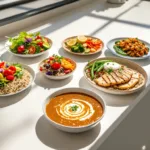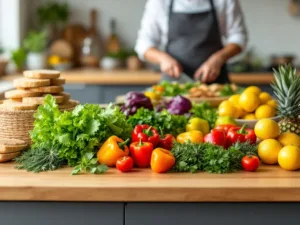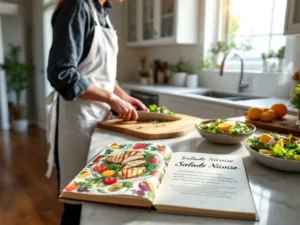How to Use Herbs and Spices to Enhance Your Healthy Food: A Comprehensive Guide to Flavor and Wellness
Introduction
In the quest for a healthier lifestyle, many of us focus on the nutritional content of our food—counting calories, tracking macronutrients, and choosing organic produce. However, one often overlooked aspect of healthy eating is the role of herbs and spices. These natural flavor enhancers not only make your meals more delicious but also offer a plethora of health benefits. From boosting metabolism to reducing inflammation, herbs and spices are the unsung heroes of a balanced diet. This article will explore how you can use herbs and spices to elevate your healthy meals, providing practical tips, examples, and insights to help you make the most of these culinary treasures.
The Health Benefits of Herbs and Spices
Nutritional Powerhouses
Herbs and spices are more than just flavor enhancers; they are nutritional powerhouses. Packed with vitamins, minerals, and antioxidants, they can significantly contribute to your overall health. For example, turmeric contains curcumin, a compound known for its anti-inflammatory and antioxidant properties. Similarly, garlic is rich in allicin, which has been shown to boost the immune system and reduce blood pressure.
Anti-Inflammatory Properties
Chronic inflammation is linked to numerous health conditions, including heart disease, diabetes, and cancer. Many herbs and spices have potent anti-inflammatory properties. Ginger, for instance, has been used for centuries to reduce inflammation and pain. Cinnamon is another spice that has been shown to lower levels of inflammatory markers in the body.
Digestive Health
Herbs and spices can also aid in digestion. Peppermint is well-known for its ability to soothe an upset stomach and relieve symptoms of irritable bowel syndrome (IBS). Fennel seeds are another excellent choice for digestive health, often used to alleviate bloating and gas.
Metabolic Boost
Certain spices can give your metabolism a boost, aiding in weight management. Capsaicin, the compound that gives chili peppers their heat, has been shown to increase metabolic rate and promote fat burning. Similarly, black pepper contains piperine, which enhances nutrient absorption and may help in weight loss.
How to Incorporate Herbs and Spices into Your Diet
Fresh vs. Dried: What’s the Difference?
When it comes to using herbs and spices, one common question is whether to use fresh or dried. Both have their advantages. Fresh herbs, like basil and cilantro, offer a vibrant flavor and are best used in dishes that require minimal cooking, such as salads and garnishes. Dried herbs and spices, on the other hand, have a more concentrated flavor and are ideal for slow-cooked dishes like stews and soups.
Cooking Techniques
Different cooking techniques can bring out the best in herbs and spices. For example, toasting spices like cumin and coriander seeds before grinding them can enhance their flavor. Similarly, adding fresh herbs like parsley and dill at the end of cooking preserves their delicate flavors.
Pairing Herbs and Spices with Foods
Understanding which herbs and spices pair well with certain foods can elevate your culinary creations. For instance, rosemary and thyme are excellent with roasted meats, while basil and oregano are staples in Italian cuisine. Turmeric and cumin are essential in Indian dishes, and cilantro and lime are perfect for Mexican fare.
Practical Tips for Using Herbs and Spices
Start Small
If you’re new to using herbs and spices, start small. Experiment with one or two at a time to understand their flavors and how they complement different foods. Gradually, you can start combining them to create more complex flavor profiles.
Store Properly
Proper storage is crucial to maintaining the potency of herbs and spices. Store dried herbs and spices in a cool, dark place, away from heat and moisture. Fresh herbs can be stored in the refrigerator, either in a glass of water or wrapped in a damp paper towel.
Grow Your Own
Growing your own herbs is a rewarding way to ensure you always have fresh options on hand. Many herbs, like basil, mint, and parsley, are easy to grow in pots on a windowsill or balcony. This not only provides you with fresh herbs but also allows you to experiment with less common varieties.
Use Spice Blends
Spice blends, like curry powder, garam masala, and herbes de Provence, can simplify the process of seasoning your food. These blends are pre-mixed combinations of herbs and spices that offer a balanced flavor profile, making it easier to season dishes without needing to measure out individual ingredients.
Examples of Herbs and Spices in Action
Breakfast: Turmeric Scrambled Eggs
Start your day with a boost of anti-inflammatory power by adding a pinch of turmeric to your scrambled eggs. Pair it with a sprinkle of black pepper to enhance the absorption of curcumin.
Lunch: Quinoa Salad with Fresh Herbs
For a light and nutritious lunch, prepare a quinoa salad with a mix of fresh herbs like parsley, mint, and cilantro. Add a squeeze of lemon juice and a drizzle of olive oil for a refreshing and flavorful dish.
Dinner: Roasted Chicken with Rosemary and Thyme
Elevate your roasted chicken by stuffing the cavity with fresh rosemary and thyme sprigs. The herbs will infuse the meat with their aromatic flavors, making for a delicious and healthy dinner.
Snacks: Spiced Nuts
For a healthy snack, toss a mix of nuts with olive oil, cumin, paprika, and a pinch of cayenne pepper. Roast them in the oven until golden brown for a spicy and satisfying treat.
Dessert: Cinnamon-Spiced Fruit Salad
End your meal on a sweet and healthy note with a fruit salad sprinkled with cinnamon. The spice adds warmth and depth to the natural sweetness of the fruits.
Conclusion
Incorporating herbs and spices into your diet is a simple yet powerful way to enhance the flavor and nutritional value of your meals. From their health benefits to their culinary versatility, these natural ingredients offer endless possibilities for creating delicious and wholesome dishes. Whether you’re a seasoned cook or a beginner, experimenting with herbs and spices can transform your cooking and contribute to a healthier lifestyle. So, the next time you’re in the kitchen, don’t just reach for the salt and pepper—explore the world of herbs and spices and discover new ways to make your healthy food truly extraordinary.
By understanding the unique properties and uses of various herbs and spices, you can unlock a world of flavor and wellness. Start small, experiment often, and enjoy the journey of discovering how these natural wonders can enhance your healthy eating habits.









Add comment